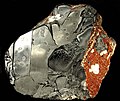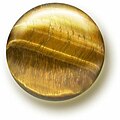shine
Gloss is an optical property of a surface that reflects light completely or partially in a specular way . If a surface is not shiny because it reflects light diffusely, this is called mattness . Just like color , gloss is a property that contributes to the visual appearance of a surface. Shine is a sensory impression and therefore depends on the viewer. In order to make the gloss of surfaces technically comparable, reflectometers are used.
Basics
Shine is created when both the lighting is focused and the surface is reflective . As a result, every point on the surface appears differently bright from different viewing angles and light reflections change with the movement of the viewer. A surface also looks very shiny if the brightness of a point in binocular vision differs greatly for each eye. In contrast, dullness occurs when the surface reflects light diffusely or there is global diffuse lighting. In the latter case, it is not possible to distinguish whether the surface is glossy or matt.
In physical terms, gloss is defined as the quotient of the directed and the diffusely reflected portion of the luminous flux falling on a surface . It can be determined quantitatively with gloss meters .
If the color of the reflected light changes with the viewing angle, this is called iridescence .
Mica, glitter, glitter effects are among the special forms of shine, which are due to local, high-gloss, small surface areas, as is also typical for the variously stored crystal surfaces of the minerals of the mica group , but also for ice or for the reflections on finely structured Surfaces such as water, or metal foil snippets ( glitter ) or metal effect pigments in a coating agent such as metallic paints .
Classification schemes
Paints and varnishes
- gloss
- Silky gloss
- semi-gloss or semi-gloss
- frosted
- dull matt
- deep matt or ultra matt
- natural matt
Minerals
In mineralogy , a distinction is made between in descending order according to the strength of the gloss
- Metallic luster
- Strongest, reflective gloss that only occurs with metals , alloys and some opaque minerals (mainly sulfides ) and corresponds approximately to a refractive index from 2.6 to over 3. Most of the minerals with a metallic sheen are colorless or gray in color with different gradations and therefore show gray to silvery reflections such as B. sperrylite and stibnite . Some "non-ferrous metals" such as copper and gold , but also some minerals such as pyrite (golden yellow), kermesite (red), hibonite (brown) and hematite (black) show a correspondingly colored luster due to their intrinsic color. In addition, thin layers of weathering can lead to colorful, iridescent shades of color.
- Diamond luster
- Brilliant shine that resembles cut diamonds or lead crystals and has a refractive index of around 1.9 to 2.6. Further examples of diamond luster are calomel , linarite , pyrargyrite and zemannite .
- Greasy shine
- Corresponds to the sheen of grease stains on paper and is mostly used to denote cloudy stones with a low refractive index between 1.7 and 1.9. Examples of greasy gloss include gahnite , cerolite and pyrochlore .
- Glass gloss
- Corresponds to the gloss of simple window glass with an average refractive index between 1.5 and 1.6. Depending on the variety, this can vary between 1.3 and 1.9 (limit to diamond gloss). Examples of glass luster include enstatite , lazulite , phenakite and uwarowite .
- Pearlescent
- (short: pearlescent, also luster): Mixture of surface gloss and opaque depth light , with iridescent effects that are typical of mother-of-pearl and pearls . Examples of pearlescent luster include brucite and smithsonite .
- Silky gloss
- Surging light, as it occurs with silk and parallel- fiber minerals or aggregates such as chrysoberyl , tiger's eye and falcon's eye . Minerals with a silky sheen show the well-known " cat's eye effect" when appropriately cut .
- Resin gloss or wax gloss
- The model here is the cloudy and less intense gloss of resin or wax with a refractive index similar to that of glass. Amber , opal and flint show, among other things, a resin or wax sheen.
- Frosted
- Description for minerals without a special shine. The breakpoints of otherwise very shiny minerals can also be matt.
Other common descriptions of gloss include semi-metal gloss, porcelain gloss, pitch gloss. Numerous mining names indicate a characteristic sheen of these minerals, such as "lead luster" for galena or "copper luster" for chalcopyrite .
- Examples of the different shine of minerals
Hematite (metallic luster)
Sphalerite (diamond luster)
Adhesion of malachite and chrysocolla (greasy gloss)
Quartz (glass gloss)
Prehnite (pearlescent)
Tiger eye (silk gloss)
Stolzite (resin or wax gloss)
Aluminite (matt)
materials
- Surface coating: gloss varnish , matting agent , metallic effect pigments , interference pigments , pearlescent pigments
See also
- Gray scale , used to assess the change in colors
literature
- Friedrich Klockmann : Klockmann's textbook of mineralogy . Ed .: Paul Ramdohr , Hugo Strunz . 16th edition. Enke, Stuttgart 1978, ISBN 3-432-82986-8 , pp. 253-254 (first edition: 1891).
Web links
- Mineral Atlas: Gloss (types of gloss in minerals)
- Geology info - properties of minerals, gloss
Individual evidence
- ^ A b c Walter Schumann: Precious stones and gemstones. All species and varieties in the world. 1600 unique pieces . 13th revised and expanded edition. BLV Verlags GmbH, Munich et al. 2002, ISBN 3-405-16332-3 , p. 48, 49 .







